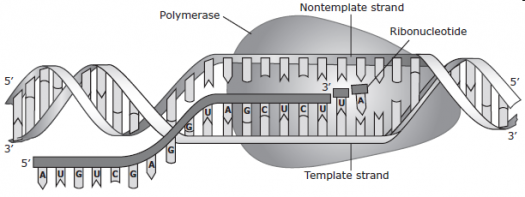Protein Synthesis Review Quiz

- 1.
In RNA, adenine bonds with uracil.
- A.
True
- B.
False
Correct Answer
A. TrueExplanation
RNA, or ribonucleic acid, is a nucleic acid that is responsible for carrying genetic information in certain organisms. Adenine is one of the four nucleotide bases found in RNA, and it forms a complementary base pair with uracil. This means that in RNA, adenine always pairs with uracil, similar to how adenine pairs with thymine in DNA. Therefore, the statement that adenine bonds with uracil in RNA is true.Rate this question:
-
- 2.
What is transcription?
- A.
the synthesis of mRNA from a DNA template.
- B.
When mRNA is synthesized by the proteins to tRNA
- C.
When the ribosomes use the genetic information to make proteins
Correct Answer
A. the synthesis of mRNA from a DNA template.Explanation
Transcription is the process in which mRNA is synthesized from a DNA template. This involves the enzyme RNA polymerase binding to the DNA and synthesizing a complementary mRNA molecule. This mRNA molecule carries the genetic information from the DNA and is later used by ribosomes to produce proteins through translation.Rate this question:
-
- 3.
What is a 3-nucleotide code on mRNA called?
Correct Answer
codonExplanation
A 3-nucleotide code on mRNA is called a codon. This sequence of three nucleotides determines the specific amino acid that will be incorporated into a growing polypeptide chain during protein synthesis. Each codon corresponds to a specific amino acid or a stop signal, allowing for the accurate translation of the genetic information encoded in the DNA into proteins.Rate this question:
- 4.
Transcribe the following DNA strand. (no spaces,add slashes, like below)AAC/TTA/AAA/GGC
Correct Answer
uug/aau/uuu/ccg
UUG/AAU/UUU/CCGExplanation
The correct answer is "uug/aau/uuu/ccg, UUG/AAU/UUU/CCG". The question asks for the transcription of the given DNA strand, which involves converting the DNA sequence into its complementary RNA sequence. In DNA, the nucleotide A pairs with T, while in RNA, A pairs with U. Similarly, T pairs with A in DNA, but in RNA, T is replaced with U. Therefore, the correct transcription of the DNA strand "AAC/TTA/AAA/GGC" is "uug/aau/uuu/ccg" in lowercase and "UUG/AAU/UUU/CCG" in uppercase.Rate this question:
- 5.
What are proteins made of?
Correct Answer
amino acidsExplanation
Proteins are composed of amino acids. Amino acids are organic compounds that contain an amino group (-NH2) and a carboxyl group (-COOH). These building blocks are linked together by peptide bonds to form long chains called polypeptides, which then fold into complex three-dimensional structures to create proteins. Each protein has a unique sequence and arrangement of amino acids, which determines its specific function in the body.Rate this question:
- 6.
Where does protein synthesis take place?
Correct Answer
ribosomeExplanation
Protein synthesis takes place in the ribosome. Ribosomes are cellular structures responsible for assembling amino acids into proteins. They are found in the cytoplasm of cells and also attached to the endoplasmic reticulum. Ribosomes read the genetic information carried by messenger RNA (mRNA) and use it to synthesize proteins through a process called translation. During translation, the ribosome reads the mRNA codons and matches them with specific transfer RNA (tRNA) molecules carrying amino acids. The ribosome then links the amino acids together to form a protein chain. Therefore, the correct answer is ribosome.Rate this question:
- 7.
What is the stage of protein synthesis shown in the image?Word Bank: transcription, translation, gene flow, mutation
Correct Answer
transcriptionExplanation
The correct answer is transcription. Transcription is the process in which the information stored in DNA is converted into RNA. It involves the synthesis of a complementary RNA strand using one strand of the DNA molecule as a template. In the image, it is likely that the process of transcription is being depicted, as it is the stage of protein synthesis where RNA is being produced.Rate this question:
- 8.
The decoding of mRNA into a protein is called what?Word Bank: transcription, translation, natural selection, or mutation
Correct Answer
translationExplanation
Translation is the correct answer because it refers to the process of decoding the mRNA sequence and synthesizing a protein. During translation, the ribosomes read the mRNA and use the information to assemble amino acids in the correct order, forming a protein. This process is crucial for protein synthesis in all living organisms. Transcription, on the other hand, is the process of synthesizing mRNA from DNA, while natural selection and mutation are unrelated to the decoding of mRNA into a protein.Rate this question:
- 9.
What is another name for protein?Word Bank: monosaccharide, polypeptide, genetic material, nucleotide
Correct Answer
polypeptideExplanation
Protein is another name for polypeptide. A polypeptide is a chain of amino acids linked together by peptide bonds. Proteins are essential macromolecules that perform various functions in living organisms, such as providing structure, facilitating chemical reactions, and serving as enzymes or antibodies.Rate this question:
- 10.
How is RNA different from DNA?
- A.
Has double helix
- B.
Has single strand
- C.
Is loacted in nucleus
- D.
Is located in and out of nucleus
- E.
Has guanine
- F.
Has uracil
- G.
Has thymine
Correct Answer(s)
B. Has single strand
D. Is located in and out of nucleus
F. Has uracilExplanation
RNA is different from DNA in several ways. Firstly, RNA has a single strand, while DNA has a double helix structure. Additionally, RNA is located both inside and outside of the nucleus, whereas DNA is primarily located in the nucleus. Another difference is that RNA contains the nitrogenous base uracil, while DNA contains thymine. These variations in structure and composition make RNA distinct from DNA.Rate this question:
-
Quiz Review Timeline +
Our quizzes are rigorously reviewed, monitored and continuously updated by our expert board to maintain accuracy, relevance, and timeliness.
-
Current Version
-
Mar 21, 2023Quiz Edited by
ProProfs Editorial Team -
Dec 11, 2017Quiz Created by
Bingmanl
 Back to top
Back to top



